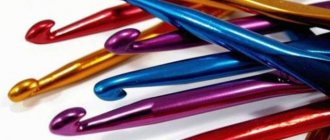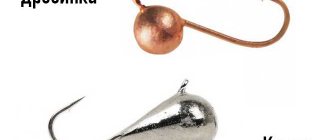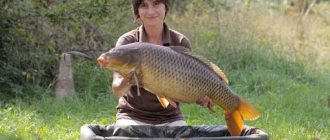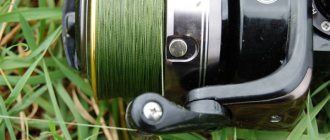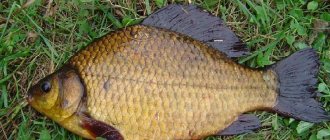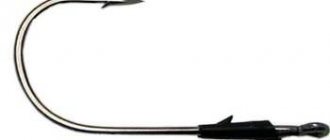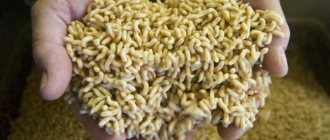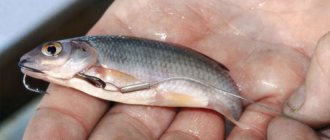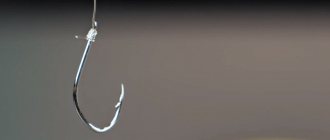Even the most thrifty angler will eventually want to replenish or update the assortment of his box of hooks. At first glance, this event may seem simple, but at the same time, choosing the right hook is always associated with pitfalls, especially for beginners.
So that you don’t get lost in the abundance of prickly accessories, we will tell you about the main points of choosing a hook for specific fishing conditions, show you an interesting video and tell you about valuable life hacks...
Content
- 1. Key points that determine the choice of fishing hook
- 1.1 How to choose the size of a fishing hook
- 1.2 How to choose a fishing hook based on its sting
- 1.3 How to choose a fishing hook by color
- 1.4 Selection of fishing hook material
- 2.1 Choosing hooks for catching small fish
- 2.2 Choosing hooks for wary fish
- 2.3 Select hooks for large baits and powerful fish resistance
- 2.4 How to choose a hook for a spinning rod
How to choose a hook for fishing: how to choose the type and size
Equipment
The main characteristic is the number. Depending on the manufacturer, they may differ. Fishermen are accustomed to distinguishing 2 categories: Russian scale and International. Additionally, there are Japanese and Finnish tables.
Most manufacturing companies use the international table when exporting goods. Let's determine what hook size is. According to the Russian measurement table, this is the distance between the fore-end and the tip (see photo below). For example, this distance is 10mm, 10 will be the number.
Models from famous companies and quality manufacturers indicate the following markings on the packaging: No. 4-0.2-7, which means the fourth No. made of wire with a diameter of 0.2 mm and a length of 7 mm. According to the Russian table (the simplest) - the higher the number, the larger the tackle. The international system is not that simple. In it, the size does not come from the distance between the fore-end and the sting, but reflects the length of the fore-end minus 1 unit. The larger it is, the smaller the hook. For example: No. 13 has a fore-end length of 12 mm, and is smaller than No. 12.
Professional manufacturers may also indicate additional information about their product on the packaging. For example, this is data on a shortened or lengthened forend. This can be used in various conditions, for example, if you choose a fly or want to weave it yourself, you need to decide on the hook number. In this case, the package will be marked 6x long shank; the number may vary.
The main points that determine the choice of a fishing hook
1.1 How to choose the size of a fishing hook
The hook size should be selected relative to:
- the magnitude of future production;
- the size of the attachment (bait) used.
Thus, hooks with a long shank are best used for baits of animal origin, for example, worms (dendroben, dungworm, sandworm), carcasses or pieces of sardine. If fishing, for example, takes place in the Mediterranean Sea, the choice should also be related to the size of the catch, which can be impressive in size. Also, hooks with a long shank are good for catching cephalopods (octopus, cuttlefish, squid), gastropods (snail), crustaceans (crab, shrimp) and other tasty inhabitants inhabiting sea waters.
Why is it better to use a forend with this particular feature? It is believed that the natural behavior in water of the same dendrobene worm, the leader of survivability in salty Mediterranean water, is always more desirable for prey (for example, mullet, locus, saragus, denis, etc.). The natural movement of the bait is preserved thanks to its correct attachment to the hook, which is often placed along the fore-end for longer survivability. However, the length can cause a poor-quality hook and subsequent loss of fish, which should be taken into account when giving preference to this hook design.
A short forend is suitable for baits of vegetable origin (bread, cereals, legumes, baits mixed with fishmeal, pilot dough, etc.). With such baits it is good to attract cautious individuals, such as crucian carp, carp, roach, dace, ram, inhabiting freshwater reservoirs and aras, television, settled in the waters of the Mediterranean Sea of Israel.
What kind of catchy bait made from dough called “pilota” is, how to prepare and use it, read here
In order to better capture the hook by the prey, we recommend threading a fishing line (monofilament or braided line) into the eye of the fishing hook from the tip side (from the inside), and then tying it to the shank of the fishing hook.
Read more about the most reliable methods of attaching a fishing line to a hook here
Is it worth increasing the size of the hook in hopes of catching larger specimens? Some will answer this question positively. Of course, the hook must be proportionate to the bait and the fish. However, as the experience of professionals has shown, in this case it is better to pay attention not to the size, but to the thickness of the wire, which makes the hook stronger and more reliable. For example, when fishing with float and feeder gear, you can use hook sizes No. 18-16 with a material thickness of 0.5 or 0.6 mm.
The beard is chosen larger; it will help to hold large fish against resistance at the time of fishing, for example, such obstinate fish of the Mediterranean Sea as barracuda, flathead, and croaker. When hooked, a large hook can tear the tissues of the fish’s oral cavity and thereby facilitate the escape of prey. A small hook penetrates deeper into the throat and clings to harder parts, while the depth of penetration into the tissue is achieved already at the moment of pulling out the fish.
Often painful fuss with the use of small hooks is rewarded by changing the sluggish bite to a more active one.
How to determine a specific hook size for certain fishing conditions, as well as the relationship between the sizes of different numbering systems, is described in detail in this article
1.2 How to choose a fishing hook based on its sting
The main task of the hook is a high-quality hook. In order to achieve this, there are such a variety of hook options. Most anglers prefer hooks with an outward point, as an inward point reduces the number of positive hooks. It’s up to you to decide which design options for the tip you use. The effectiveness of each of them depends on the specific conditions and habits of a particular fish, as well as the preference of the fisherman.
Read more about the number of stings on one hook (one, two, three or more), the features of fishing with such hooks here
1.3 How to choose a fishing hook by color
The main “color” rule is that the color of the fishing hook should blend with the color of the bait. For example, a white hook is suitable for dough, and a red hook for a worm or for catching a predator.
Some fishermen argue that the color of the accessory should not be matched to the color of the bait, but to the shades of the water. For example, when fishing in clear, clean water, it is better to use dull hooks, but fishing hooks of bright colors work well with muddy water.
1.4 Selecting a hook based on material of manufacture
The quality and composition of the alloy used in the production of hooks is an important characteristic that deserves attention when choosing.
Read more about the types of material, its features and distinctive characteristics here
How to choose a fishing hook
Once upon a time, back in Soviet times, high-quality fishing equipment was in short supply - even imported fishing line or hooks were obtained through connections, paying exorbitant prices. Nowadays it’s enough just to go to a specialized store and your eyes will run wide from the abundance of offers. In this case, choosing a hook for specific fishing conditions turns into a super task, because even sellers sometimes cannot give intelligible professional advice. You have to rely on the manufacturer's information and your own knowledge.
Today we have set a task - to help you gain this knowledge in the simplest possible way, bypassing the long path of trial and error. We will tell you what these small but important elements of equipment are, and help you select options depending on fishing conditions, fishing method, type of intended prey and bait. Moreover, we will teach you how to properly store and improve your hooks so that they last as long as possible. There is nothing more disappointing than missing a fish due to imperfect equipment, so let's try to avoid this trouble!
- The importance of proper selection
- Elements of a fishing hook
- Classification by size
- Form
- Materials and colors
- Basic principles for choosing hooks
- Angling tips
Selection of hooks for specific fishing conditions
2.1 Choosing hooks for catching small fish
If we talk about the nature of the bite of small representatives of freshwater basins, then we should talk about the sharpness, speed and depth of swallowing the bait. For an angler, when catching fish such as bleak, rudd, bream, roach, it is very important to quickly take out the hook and change the bait, since small fish can move to another place.
In such circumstances, we recommend using hooks that have the following characteristics:
- number No. 14-18;
- long forend with a bend to the side.
Hooks with such characteristics not only work well when hooking, but also ensure quick removal of the sting from the soft tissues of the prey.
2 Choosing hooks for wary fish
Athletes fishermen use hooks with the following characteristics to catch white, peaceful fish:
- thin wire;
- small size;
- a small beard with a deviation from the sting axis of no more than 15 degrees.
This is due to the fact that in sports they mainly use very delicate and small baits in the form of bloodworms and maggots, which can remain alive on the hook for a long time and wriggle attractively on it. As for amateur fishing, this hook size can be successfully used on less catchy days.
2.3 Select hooks for large baits and powerful fish resistance
If you are going to catch large chub, ide, bream or medium-sized carp, then it is better to use large-sized attachments (bait) and appropriate hooks, preferably with an increased bend of the sting and a small shank. Firstly, this will allow you to better detect prey and secondly, it will keep you caught. Suitable hook sizes: No. 10-16.
If the intended prey belongs to powerful opponents, such as barbel, silver carp, grass carp, then it is better to start choosing a hook with a material that requires thick wire, since the strength of the accessory is important. Also, do not forget about the wide bend of the hem, the long tip and size No. 4-10. This is a classic crochet hook.
In the store, you can contact the seller with a request to choose a hook for catching a specific fish, for example, carp or catfish, since there are special hooks for them.
You can read about the features of carp hooks, their types, rules for choosing and using them for catching trophy carp here
2.4 How to choose a hook for a spinning rod
Spinning fishing involves the use of specific fishing hooks (jigs, offsets) designed for various types and sizes of artificial baits (slugs, creatures, silicone worms, twisters, vibrotails, etc.)
How to choose a hook for fishing with silicone baits is written in detail here
Storing hooks.
Do not store hooks “in bulk”, in one pile. In addition to the fact that in this case they are inconvenient to use, they become dull and, under certain conditions, may even be damaged.
They should be stored in a special multi-section box. The bottom of the box is covered with foam rubber, lightly soaked in machine oil, into which hooks are inserted according to size and type. When transporting fishing rods, hook them onto the rubber rings placed on the butts of the rods.
Hooks, snap hooks and other fishing accessories will not rust if you add a little starch to the box where they are stored. If rust does appear on the hooks, you need to stick them in soap for a while, and the rust will disappear.
Every fisherman has an empty box of Kyiv hooks. On the side, almost at the very base, below the edge of the lid, a hole of 1 - 1.5 mm is pierced with an awl. Then, having opened the box, the leashes are passed into this hole from the inside and pulled together until the hooks stop in the hole. So, the hooks are in the box, the leashes are outside the “storage chamber”, it is closed with a lid. If a fisherman wants to use a box in which the depth of the lid is equal to the height of the box, then he must make a window in the edge of the lid. For small hooks with a short shank, and the smallest jigs, if there are many of them, the hole should be made not on the side of the box, but in the center of its lid.
Useful tips
Advice on what to do if a small hook is uncomfortable to hold, or it slips when the bait is hooked on it:
- Hold by the forend, not the eye.
- In some situations, use a cambric (a piece of small-diameter plastic tube that is made by stripping the insulation from a wire, then heating it to make it flexible and stretching it onto a fishing line and then onto a hook).
Tips for eliminating the fragility of domestic (Russian) hook:
- Place your fragile hooks on the metal plate.
- Place the plate on low heat.
- When the heating temperature of the hooks reaches 300 degrees (purple stains on the wire), complete the procedure.
- Leave the plate with hooks to cool naturally.
- The strength of the equipment material has been achieved.
A tip for eliminating the softness of a domestic hook is to do the same as when eliminating the fragility of an accessory, but heat it to a higher temperature and when the hooks begin to glow with a characteristic orange tint, immediately lower them into oil or water.
An exotic tip for eliminating excessive wire thickness is to place the hooks in a mixture of nitric and 15 percent hydrochloric acid (aqua regia) and when the thickness decreases, remove them from the solution.
Don't forget to check the sharpness of the hook before using it. How to do this, read here
The importance of proper selection
Unfortunately, not all fishermen, especially in the early stages, attach due importance to the selection of this small but super-important element of equipment. The main principle is that it fits in the fish’s mouth and the bait does not slip off, and the rest is details. However, this is catastrophically not enough for successful fishing!
Take a closer look at the products of fishing tackle manufacturers: you will see that hooks are differentiated by size, shape and even color. You will see a variety of single, double, triple elements, with different fore-end lengths, with and without barbs, with blades or rings, all kinds of configurations and color schemes.
Honest manufacturers indicate the main characteristics of hooks on the factory packaging, and they correspond to reality. Let us assume that we are looking at really high-quality products, made of steel with a reliable coating and good sharpening.
However, the angler must take into account other factors that affect fishing performance:
- Fish activity . The less active the fish, the more wary it is of all sorts of unusual things. This means that a large and shiny hook can scare it away from the bait.
- Trophy weight . Naturally, carp and bleak are caught on hooks of different sizes: the miniature version will not withstand the pressure of the giant.
- Type of bait . For plant baits, smaller options are usually used than for animals (with the exception of ultra-delicate bloodworms).
Now let’s talk about the nuances of choosing hooks in as much detail as possible, and in a language that a novice fisherman can understand.
Types of hooks and their main characteristics
It is important to know that a fishing hook comes in single, double and triple designs. They are classified by shape, material and size.
Hooks are also distinguished by eye (blade, ring), bent or straight, with additional teeth and different sharpening. But this already applies to modifications of basic forms.
Fishing hooks come in the following types: single, double, triple, “quadruple”, “quinary”.
According to their purpose, types of hooks are divided into carp, vobbin, fly, and catfish.
There are ten main types of hooks:
- “Aberdeen” - medium thickness, single-flex, elongated forend, classically rounded;
- “Viking” - forged, single-bend (only when tying flies);
- “Weak” - “bird’s beak”, powerful, has a sting (bent inward), and a small beard;
- “Carlysle” - long forend, double-bent (for smallmouth fish);
- “Kirby” - medium thickness, double-bend, good for hooking, popular;
- “Crystal” - has a sharp bend to hook onto the sting, double-bending, or maybe single-bending;
- “Round bend” is more powerful than Aberdeen, although it is similar to it (industrial fishing);
- “Limerick” - has a sharp, wide hook, hooked and bent along the sting;
- O. Shаughnessy — powerful, single-bending hook, forged (for large fish);
- “Wide hook” - only for cyprinids.
What parts does a fishing hook consist of?
The design of a fishing hook: head (attached to the fishing line), fore-end (straight from the head to the hook), prying (between the fore-end and the sting), sting (sharp end of the hook).
Sizes and shape of fishing hooks
Fishing hooks (photos and size table will be below) come in two main sizes, these are Russian size numbering and international according to the Redditch scale. It is important for us to measure the width of the hook (the distance in millimeters from the tip to the shank). The main established size numbering is from 2 to 16 mm.
For reference: there are also size classifications: Finnish, Japanese, international, Chinese. The domestic one is the simplest and most convenient.
The shapes of fishing hooks depend not only on the choice of fishing and fish, but also on the brands produced. Everything here is replete with variety - type, shape, material, color. For fishing by angling, the choice of hook is based on the basic shapes, the seller’s advice, and the angler’s preferences.
Basic forms of hooks for fishing:
- single - suitable for fishing from the bottom or boat, requires a float;
- double - loop-shaped design for live bait;
- triple - several elements on the fore-end (for spinning rods, bait, attachments).
